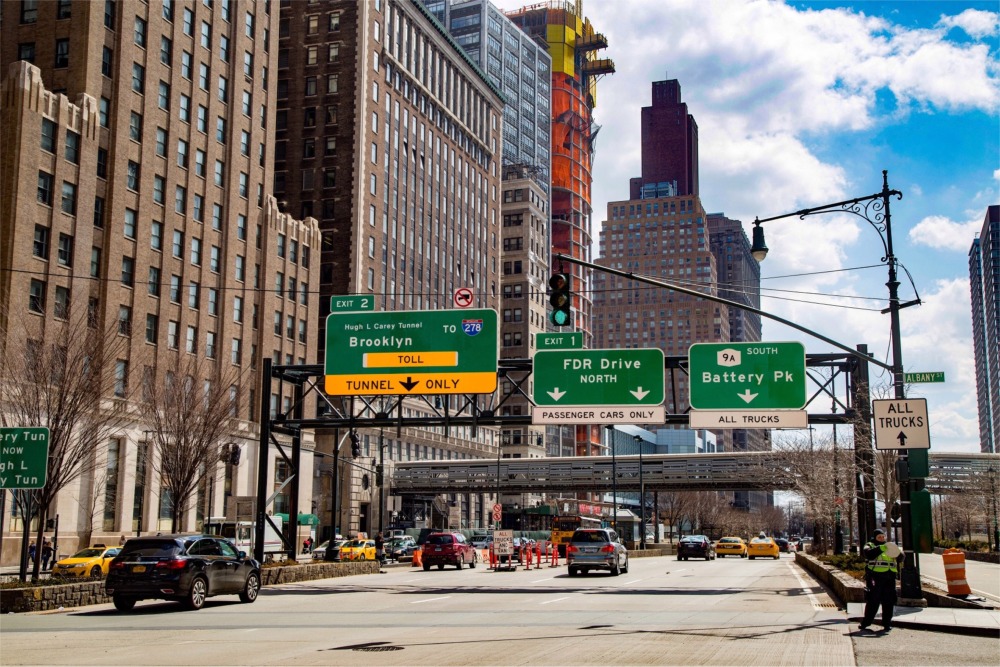West Street and
Albany Intersection Manhattan
Home > New York State Photographs > New York > West Street and Albany Intersection Manhattan

The intersection of West Street and Albany Street on the west side of Manhattan was alive with movement and sound. The afternoon sun was high in the sky, casting its golden light over the cityscape as people walked briskly along the sidewalk, passing shop fronts and restaurants. Cars and taxis moved up and down the street, the horns and engines reverberating off the buildings.
In the background stood the magnificent old New York Evening Post building, its ornate façade and grand entrance illuminated by the sunlight. It stood as a silent witness to the hustle and bustle of the city; a reminder of a bygone era.
The photograph that had been taken of this scene was a thing of beauty - a snapshot of the city in all its diverse glory. The white fluffy clouds drifted in the azure sky, the buildings lining West Street basked in the golden light, and the green street signs pointed the way to Brooklyn, FDR Drive, and Battery Park. It was a stunning picture that captured the essence of the city and its many stories.
West Street
West Street is the southern section of Route 9A and is part of the Joe DiMaggio Highway (commonly called the West Side Highway). West Street is a significant north-south thoroughfare located on the west side of Manhattan, New York City. It plays a crucial role in the borough's transportation network and offers scenic views of the Hudson River. Here's an overview of West Street in Manhattan:
Route and Geography
West Street runs parallel to the Hudson River along the western edge of Manhattan, extending from the southern tip of the island near Battery Park (now The Battery) to Gansevoort Street where it transitions to 11th Avenue.
The street traverses several Manhattan neighborhoods, including the Financial District, Battery Park City, Tribeca, and the West Village.
Transportation Significance
West Street is a major north-south thoroughfare in Manhattan and serves as an essential transportation artery for the borough. It helps facilitate the flow of traffic along the west side of the island, providing a route for commuters and travelers.
The street merges with and intersects various other roadways, including the West Side Highway, the Brooklyn-Battery Tunnel (also known as the Hugh L. Carey Tunnel), and the Holland Tunnel. These connections make West Street a vital link in the city's road network.
Scenic Views
West Street is renowned for its panoramic views of the Hudson River, offering glimpses of the river, boats, and the New Jersey shoreline. These scenic vistas make it a popular route for pedestrians, cyclists, and motorists seeking picturesque views.
The Hudson River Park, a sprawling waterfront park, lines sections of West Street, providing green spaces, recreational facilities, and walking paths where people can enjoy the waterfront and take in the views.
Historical Significance
West Street has a historical legacy dating back to the development of Manhattan. In the past, it was characterized by its proximity to the Hudson River and was lined with piers and warehouses, reflecting the city's maritime history.
Over the years, West Street has undergone significant redevelopment and beautification efforts aimed at improving the waterfront and enhancing the quality of life for residents and visitors.
Community and Landmarks
West Street passes near or through several notable landmarks and institutions, including Battery Park (The Battery), the World Trade Center site, and the Whitney Museum of American Art in the Meatpacking District.
West Street, with its mix of residential, commercial, and recreational spaces, offers a diverse urban experience. Its transformation from an industrial waterfront into a vibrant urban corridor mirrors the evolution of New York City as it continues to adapt and grow.


